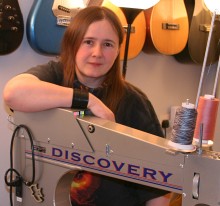To get to the new quilt exhibition you have to first brave the shop. I managed that rather too well, I could see quilts. I then had to go back and buy the book of the exhibition. I wanted to save myself having to draw everything and the book certainly did that. It's nicely produced with lots of closeups. I am very pleased that one of the staff suggested it as it did save me a lot of work. I may try to descripe the quilts later, right now I am still somewhat overwhelmed.
Having to walk through the shop on the way out was a little unfortunate. They had several books I haven't seen before and well they just fell into my hands honest. This meant I had to walk back to the car to drop my bags off before looking around the main house. Turns out that was exactly the right thing to do, I bumped into the gate attendant. I hope I managed to reassure him that I loved the museum. Although I hadn't seen half of it by then.
The main building is a proper museum. You start on the lower floor with a quick overview of American history. There is a farm house that converted to a tavern, complete with sofa bed (well settle with pull out). Just goes to show nothing it new. From there you head up to the top floor. Again you take a walk through time, this time via rooms of houses. Many of these rooms have textile links. There are the tools for preparing and spinning linen in the first room, quilts in most of the otheres. The audio guide was a little slow pased for me, but it was quite good on some of the sewing. The best bit was I could pause it to sketch quilting designs. I was struck both in the main house and in the extra exhibition but how similar my quilting is to traditional patterns. Things I thought I had made up were being used in the 1800's. There really is nothing new.
Eventually you reach the textiles room. People had described thi s to me, but it hadn't really sunk in. There are lots of quilts mounted in frames like you got in postr shops. That I had mostly grasped, but I hadn't realised how close this brings you to the quilts. The quilts are behind a sheet of plastic, but you can still feel the thickness of the binding or the applique. I loved this. There are a wide range of quilts on display in this room and so much to learn from them. They also have their stories where known. One, Fanny' Fan, was silks on black satin in fan shapes with decorative stitching. It's not really my thing but I do like the satin and was surprised how well it had survived. It was made by a Quaker, who wanted to marry someone of another religion. As this wasn't allowed she never married and the quilts stayed in her hope chest. Then it really hit me. I was standing in the midst of all these peoples lives. These quilts must all have stories just as interesting and maybe more so. How fantastic to be so up close and personal with them. There were also some rooms where you were walking on historic rugs again covered with plastic. It adds a lot to the feeling of immersion the museum has worked so hard for.
Anyway, I've finished my cookie (baked on site and very nice) and my drink and the staff are trying to clear up. I should make a move and maybe get to look at the grounds.








3 comments:
Thanks Ferret. I keep being told 'I should go there' too. Perhaps I can persuede John that one of his vintage cars needs a run somewhere appropriate as it's not a million miles away!
You really should. Especially while they have the extra quilt exhibition on. I suspect their lunch would be pretty good too, I was too late so had to have cake and cookies but everything in the kitches smelled great.
Hi, a while ago you commented on my blog about thw feathed snowflake that you'd like to do a quilt with feathers with different fills. Well, I came across this from Linda Taylor last night and fell in love with it - and thought of you: http://www.thequiltshow.com/os/shows.php/episode/604 . I've been doodling feather fillers and practising ever since, and have found she has three fancy feathers books I want to get!
Post a Comment